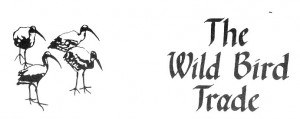Tanzania has earned an international reputation as a leader in the field of wildlife conservation and is world famous for its national parks and wildlife. Nearly a quarter of the country is under some sort of wildlife protection order. Despite this Tanzania is the second largest exporter (after Senegal) of wild caught birds in Africa.
The bulk, if not all of Tanzania’s wild bird exports, are of its own native species, unlike some Far Eastern exporters/markets. There are over 200 registered bird and animal exporters. The main trade is in Estrilid finches (waxbills, cordon bleus etc), weavers, bishops, whydahs and, to a lesser extent, native parrots especially the endemic Fisher’s Lovebird. Large bird exports are dominated by flamingoes, storks (especially marabou), ibises and crowned crane. Trapping appears to be centred in Dodoma, Shinyanga and Kilimanjaro regions with holding grounds in Arusha and Dar es Salaam.
CONCERN ABOUT WELFARE AND CONSERVATION
Increasing concern is being expressed in Tanzania and internationally about the welfare and conservation aspects of the trade. It should be stressed however that the bulk of the Tanzanian trade is legal, according to Tanzanian and international law. But there is evidence of some illegal acts being committed.
Studies of the wild bird trade elsewhere have shown that there are huge losses suffered at capture, in the holding grounds and whilst being transported and there is no reason to suppose conditions in Tanzania are any different. In a well publicised case recently at least 1,200 birds died miserably on a flight from Tanzania to Heathrow. In 1982 a report by Kim Howell of the University of Dar es Salaam made a number of recommendations which helped to stop the trade in the yellow-collared lovebird (only found in a wild state in Tanzania). In 1948 Moreau (the doyen of African ornithology) commented on the huge numbers of lovebirds being exported (40-50,000 per annum) and in 1987 and 1988 a total of 183,607 live imports of lovebirds were reported, Tanzania being the source of the majority. 43% of birds imported into Britain from Tanzania in 1988 and 1989 were of unidentified species. Whilst there may be some excuse for not identifying non-breeding plumage whydahs or weavers there should be no excuse for not identifying families such as bar bets, starlings, coots, mousebirds, turacos, hornbills, flamingoes, lovebirds, rollers, waders and orioles.
REGULATION
The Wildlife Conservation Society of Tanzania was partly formed in 1987 because of the growing concern about unregulated exploitation of wild birds. As a signatory to the Convention on International Trade in Endangered Species (CITES) Tanzania has agreed to regulate its trade in CITES Appendix species. No CITES Appendix 1 species (the highest level of protection eg: elephants) are regularly exported but a number of Appendix 2 species
Earlier this year a joint campaign was launched by the Royal Society for the Protection of Birds, the Royal Society for the Prevention of Cruelty to Animals and the Environmental Investigation Agency to ban the import of wild caught birds into the EEC. The USA has already decided to phase out all imports of wild caught birds. As a result of concerns about the current population status of Fischer’s Lovebirds, the CITES EEC Committee imposed a temporary ban on the import into EEC countries of these birds on January 16th 1991. Many airlines (including KLM and BA but not Egypt Air and Air Tanzania) have banned the carrying of wild caught birds. There is also currently a MAFF imposed ban on all bird imports into Britain from Tanzania. A consignment of Tanzanian birds in 1990 was found to contain Newcastle Disease and this ban will continue until the Tanzanian veterinary authorities satisfy the British that their procedures are adequate.
Zul Bhatia

